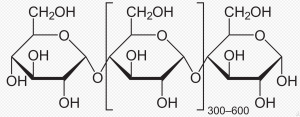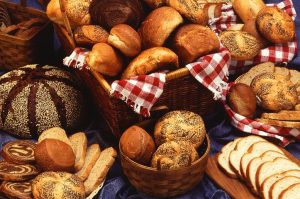Dietary carbohydrates have been so demonized, admitting to your love of bread and pasta can make you feel like an addict in a 12 step program. If you’ve tried to go Keto or attempted Atkins, there was probably a point where you would have gladly bartered your grandmother for a baked potato or a bagel with schmear. Thankfully, Prevention has good news for carb-lovers, and it turns out it’s not all that new. Based on studies from 2009 that actually expanded on a discovery from the early 1980s, nutritionists are saying almost any carb can be manipulated into a type of carbohydrate that not only helps you lose weight but can also make you healthier.
The “RS” Factor

Amylose is RS’s secret weapon that makes carbs harder to digest. Image via NEUROtiker/Wikipedia
There are two types of carbohydrate molecules that make up any starch: amylopectin and amylose. Amylopectin is highly branched, and they’re the ones that affect blood glucose and insulin levels. Amylose, however, is linear and limited, and they don’t tend to digest so well. Actually, Amylose starches don’t fully digest in the small intestine, and it’s this resistance to digestion that has earned them the title of “Resistant Starches” (RS).
What RS Means for Weight Loss

RS makes you feel fuller, faster, so you’re less likely to overeat.
Image via Rob and Stephanie Levy/Flickr
Your body can’t absorb what it can’t digest, so foods with a high RS factor offer all sorts of benefits when it comes to weight loss. Prevention says Resistant Starch can be considered a dietary fiber and that it works like other fiber does, taking up room in your stomach to make you feel fuller faster so you’ll eat less. In addition to that benefit, RS has been shown to actually turn off hunger hormones, offering more help in eating less. What’s more, nutrients are released into the bloodstream at a slower rate after eating RS, so your appetite will remain stable.
According to Precision Nutrition, you’ll only use around half the calories per gram when eating RS versus consuming other starches. That means only 50 percent of the RS calories you eat will be absorbed by your body. Since you can’t digest RS, it gets moved along from your small intestine to your large one, where it ferments and creates butyrate, a beneficial fatty acid that programs your body to use stored body fat and recently consumed fat for energy. By making sure that as little as 5.4 percent of the carbs you eat are RS, you could burn 20 to 30 percent more fat after a meal.
RS Fights Disease
The butyrate that encourages your body to burn fat also protects the colon lining, so it hinders the absorption of things that can cause cancer and helps your colon resist DNA damage that can lead to diseases such as cancer. Also, the fermentation process that RS promotes encourages high levels of healthy bacteria in your gut which results in a strong immune system. Plus, when RS bypasses the digestion process, your blood glucose and insulin levels stay on a more even keel. That’s good news not only for diabetics who thought they had to say “buh-bye” to carbs but also for those concerned about heart disease caused by arteries clogging up and hardening when blood sugar and insulin levels get chronically high.
Making Starch Resistant
Some foods already carry RS, such as whole grains, legumes, and starchy vegetables and fruits like bananas. The starch in certain foods can be manipulated, however, to turn it into RS, and the process is so simple you may already be doing it for some of the carbs you consume. Apparently, heating and cooling foods such as pasta, potatoes, rice, tortillas, and bread crystallizes part of the starch into RS. That doesn’t mean you have to eat your baked potato cold, but allowing it to cool off after dressing it and before you eat it will increase the RS. Freeze your bagels and bread (they’ve already been heated when they were baked), and run cooked pasta under cold water–the heating and cooling cycle is what transforms regular starch into RS. And, if you want to get even more RS in your diet, make pancakes and bake muffins using RS-rich flour in place of about 1/4 to 1/3 of the all-purpose flour called for in recipes. Just look for “Hi-Maize Natural Fiber” on the label.


